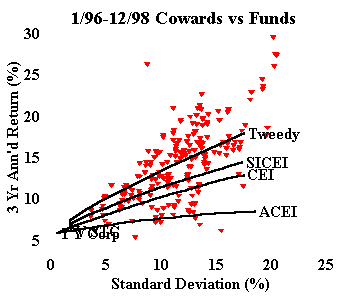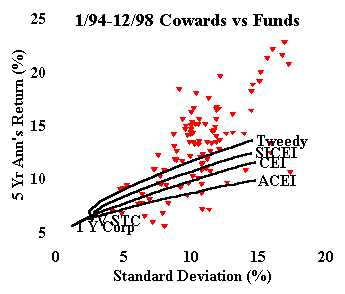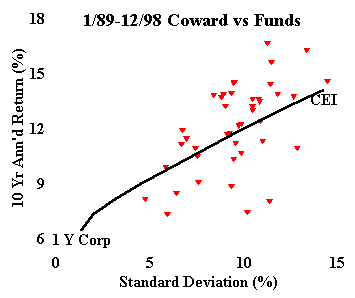Efficient Frontier

William J. Bernstein
Efficient Frontier

William J. Bernstein
![]()
The Coward's Update
In September's Coward's Update, I concluded that with the continued dominance of the S&P 500 things couldn't get much worse for the cowards. I was wrong. Although the last half of the year was a roller coaster for all global assets, the bumps were softer and the rebounds were better for everybody's favorite blue chips. Here's the bad news for the cowards for 3, 5, and 10 years:



For those of you unfamiliar with the cowards, take a look at the July 1997 update for a detailed description.Over the past 3 and 5 years, the supposedly hapless professional global fund managers have bested our fearless automatons. The reason is not difficult to fathom: in the past decade every penny you invested outside big US growth stocks cost you dearly. Consider the following 3-year and 5-year returns for the index funds tabulated below:
Index (Index Fund Sampled) 3 Yr. Return 5 Yr. Return Continental Small Companies DFA Continental Small Compny 15.15 11.13 Emerging Markets (Equally Weighted) DFA Emerging Markets -6.47 NA Small Japanese Stocks DFA Japanese Small Company -26.00 -12.74 EAFE Index DFA Large Cap International 9.88 9.57 Pacific Rim Small Companies DFA Pacific Rim Small Compny -18.78 -14.47 US Small-Medium Companies DFA U.S. 6-10 Small Company 11.37 12.15 US Small Companies DFA U.S. 9-10 Small Company 10.21 13.17 UK Small Companies DFA United Kingdom Small Co 6.08 6.71 REITs DFA/AEW Real Estate Secs 10.56 6.78 S&P 500 Vanguard 500 Index 28.16 23.96 Emerging Markets (Cap Weighted) Vanguard Emerg Mkt Stk Idx -7.60 NA EAFE-Europe Vanguard European Stock Idx 24.74 19.32 Precious Metals Stocks Vanguard Gold & Precious Met -16.48 -12.05 US Growth Stocks Vanguard Growth Index 33.87 27.79 EAFE Pacific Vanguard Pacific Stock Idx -11.14 -4.01 US Value Stocks Vanguard Value Index 21.91 19.79
It's not surprising that the global fund managers, favoring conventional portfolios heavy with Microsoft and Merck, have done so well. The worst performing automaton was the academic coward, with its heavy exposure to Japan and very small stocks. The best was the Tweedy Browne coward, which avoided these areas. Perversely, the more passively managed the coward, the worse it performed.It's well to step back and consider some market history. Ten years ago the Japanese were buying up the crown jewels of American real estate and industry, fatuous novels were being written about a world controlled from Tokyo, and the Nikkei was the place to be. Twenty years ago? Real estate and gold. And thirty years ago? The one-decision big growthies of the Nifty Fifty. Sound familiar? In each case, capitulating to the era's asset class zeitgeist would have been a disaster.
On a more prosaic note, the last 5-year period the S&P 500 outperformed foreign stocks was 1979-84, with five year annualized returns of 17.27% and 10.06% (EAFE), respectively. The annualized return for the following five years was 20.41% for the S&P and 36.52% for the EAFE.
So, patience. The cowards will soldier on. You'll see them again next year.
copyright (c) 1999, William J. Bernstein